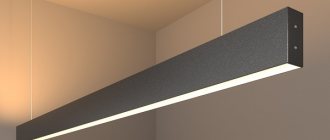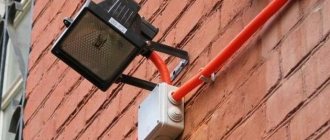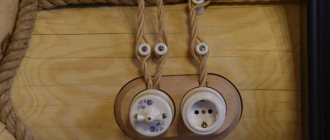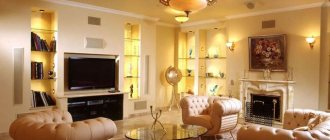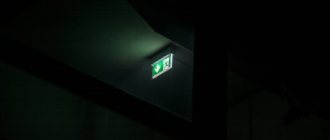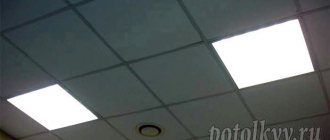Lighting in the basement is an issue that requires special attention. This is due to the fact that the underground room has certain features that must be taken into account when organizing any electrical work.
When installing lighting in the basement, you should not skimp on purchasing high-quality lamps, protection and emergency shutdown devices, reliable cables and wiring. In addition, additional costs may arise if it is necessary to organize external wiring (outside the basement), as well as when switches and sockets are brought to the first floor of a country house.
In some cases, even professional builders advise country homeowners to invite electrical specialists to install electrical wiring in the basement. Safety must come first here. It’s better not to think about savings, because, according to statistics, 20% of fires in private homes occur precisely because of problems with wiring on the ground and first floors of the building.
Norms and requirements
An essential feature of the basement is its complete or partial immersion in the ground. With such a depth, there is constant contact between the walls and the ground, and the temperature difference between the room and the ground can lead to the appearance of condensation, which is the worst neighbor for electricity. Depending on the presence or absence of moisture, the basement can be damp or dry, heated. In the latter case, the methods for installing electrical wiring will be practically no different from a house or apartment, however, wet rooms require compliance with a number of standards and requirements in terms of lighting.
In accordance with clause 1.1.13 of the PUE, almost all basements are classified as high-risk premises due to the concrete floor and high humidity.
Therefore, the most appropriate, from the point of view of electrical safety, are the following points:
- In accordance with clause 2.1.43 of the PUE , lighting wiring, supporting structures, boxes, electrical sockets must have a sufficient degree of protection from moisture, IP44 and above will be considered the minimum acceptable.
- According to clause 7.1.37, the laying of wires in non-combustible structures can be carried out inside the walls, however, in damp and especially damp rooms it is recommended to do it openly.
- In accordance with clause 6.1.16 of the PUE, especially hazardous premises must be powered from a reduced voltage with a rating of no more than 50 V, or from an isolation transformer for each lamp, or with the installation of an RCD.
- Due to the geometric parameters of the basement, closed lamps with a metal grill should be used, which reduces the likelihood of mechanical damage to the lampshade.
The basis of safety is prevention
As mentioned above, to organize lighting in a cellar or basement, you need to choose high-quality materials that can withstand the effects of moisture and biological factors.
Also, do not forget that under no circumstances should you leave the light on when you leave the basement for a long time. It is necessary to completely turn off the electricity in a country house if you leave it for at least a few days. After all, if the wiring is improperly organized or an accidental short circuit, a fire from the basement can quickly spread throughout the house.
Once every few months you need to go down to the basement (even if you don’t use it) and be sure to inspect the wires, lamps, cables, electrical panels - in general, all the wiring and all the elements that are directly connected to it.
By and large, the installation of lighting in the basement, with the exception of some points, is not much different from the same events in the living rooms of a country house.
Types of lighting used
Depending on the design features of the basement and the immediate purpose of the room, both natural and artificial lighting can be used. Each type has its own advantages and disadvantages, but the optimal result can be obtained by combining both options.
Rice. 1. Combination of natural and electric lighting
Natural
The main advantage of natural lighting is the ability to use it for free. However, this advantage is significantly offset by time constraints, worsened by weather conditions, etc. Also, we should not forget that the basement is most often located underground, so getting sunlight can be extremely problematic. For this purpose, either windows or tunnel lights are used.
The first method is the simplest, but to implement it, part of the basement must rise above ground level or be located in the basement. At the same time, windows, due to their small dimensions, provide little light; when oriented in space, the intensity of illumination depends on the position of the sun. Most windows need to be protected with metal bars from possible impacts.
A tunnel light is used to illuminate basements that do not have direct access to the street; it is also called a light guide or light well.
Rice. 2. Construction and application of a tunnel lamp
As you can see in the image above, the tunnel light consists of three main elements:
- dome – designed to collect and focus sunlight;
- shafts - transmits the collected flow from the street into the basement due to the reflective surface of the walls;
- diffuser - redistributes the light flux coming from the shaft along the perimeter of the illuminated basement.
The use of such equipment does not require connecting the lighting to the electrical network, however, at night you will not be able to navigate the basement normally.
Electrical
Electric lighting is powered by an electrical source, so it can be used at any time of the day. The source can be either a household network or portable batteries, portable flashlights, etc.
However, in most cases, no one thinks about the microclimate in the room, the presence of moisture, the condition of the floor covering and simply connects electricity from the 220V input. And this solution is only suitable for basements containing living space that is completely dry and has floors other than concrete.
Selecting the type and installation location of luminaires
If the basement has a separate entrance on the street, then it is advisable to provide it with street lighting above the door. This option will allow you to move safely in the dark and will help you open the door faster. A small lamp or spotlight mounted on a wall or under a roof with a downward flow is suitable for this. If there is another lighting device installed nearby that also provides lighting for the entrance to the basement, you can limit yourself to only that.
Since most basements are excavated to a certain depth, fairly low ceilings are used in almost all rooms. Therefore, to avoid hitting your head on a low-hanging lampshade, it is more advisable to install the lamp on the wall.
Rice. 3. Example of installing lamps on the wall
Depending on the type of basement and the purpose of lighting in it, the following types of lamps can be used:
- spot – suitable for small rooms where you are interested in a specific area or a small spot of light will be more than enough to perform any actions;
Rice. 4. Use of spotlights
- tubular or rectangular - most suitable for a long room where it is necessary to illuminate the perimeter or any objects;
- spotlights or track lights - suitable for narrow corridors, where the entire route can be illuminated from one point.
It is advisable to install lamps on the ceiling only in cases where the height to the ceiling is at least 2.5 - 3 m. The area of the room can be any size, since the missing space can be easily covered by a group of lighting fixtures. Please note, no matter what model of lighting device you choose for the basement, the body and parts must be resistant to corrosion.
Based on the type of light bulbs, it is better to connect lamps with LED lamps. They are the most economical and are not picky about temperature changes. But if you rarely use light in the basement or want the lighting device to also perform a heating function, you can also install an incandescent lamp.
Wiring Methods
There are two main methods that are used for lighting in a cellar or basement: external and internal.
Internal wiring is used in cases where chemical fertilizers and other materials that can have a negative effect on wires and electrical elements are supposed to be stored in the basement.
When carrying out external wiring installation, all laid cables are still hidden in separate casings or channels in order to minimize the impact of biological factors, moisture, soil and building materials.
Experts recommend choosing the external type of wiring installation, because this allows you to reduce the financial costs of organizing lighting, as well as provide direct access to cables during repairs and maintenance.
Selecting the type and location of sockets
The type of outlet must prevent the possibility of condensation entering the structure. For this purpose, closed, sealed models are suitable for you, where the plug contacts are closed with a special cover.
Rice. 5. Sealed socket
Installation of sockets is carried out in the most convenient place at a height of at least 1 m from the floor on a dielectric lining. The socket is connected with a cable through a sealed input; damage to the integrity of the housing and moisture penetration inside is unacceptable. Please note that you should not connect the power or lighting line from above, as condensation, accumulating, can get inside.
Selecting the type and location of switch installation
To illuminate a damp basement, a classic key switch will not work; take a sealed model in which accumulated condensate cannot reach current-carrying elements.
The installation location of the switch is selected based on the following considerations:
- the installation height of the switches must be at least 1 m from the floor, otherwise in the event of flooding with groundwater you will be left without lighting;
- the lighting switch in the basement should be located at the entrance, since in most rooms there are no other light sources, and it will be difficult to move anywhere;
- The type of switch can be a key switch or a packet switch; the latter option has some operating features; for some family members, turning it on may be problematic.
Rice. 6. Sealed switches
Organization of lighting in the basement
To organize lighting in the basement, you need a special approach. This is due to the materials used and the specificity of the room, as mentioned above.
Considering that the walls of modern houses are made of brick, concrete, foam concrete, you don’t have to worry about their fire resistance. However, you should take into account the increased humidity in underground rooms, which can negatively affect electrical wiring and fixtures.
A step-down transformer.
Wiring and its main elements should always be made waterproof, because even high-quality waterproofing can crack under certain conditions.
Here are some simple recommendations for those who want to add lighting to the basement:
- It is not recommended to use voltages higher than 36 V. To ensure the required voltage, be sure to purchase a step-down transformer.
- When laying various cables, rollers and insulators must be used.
- It is better to buy lamps that are resistant to moisture and have a completely closed socket.
For your own peace of mind, invite an electrician who will draw your attention to the specific nuances of your particular premises. You can make a lighting system in the basement yourself, knowing the basics of electrical engineering and understanding how lamps, electrical panels, protective elements and residual current devices work.
It is important to understand that saving should not be your priority at this stage. After all, incorrect installation or incorrectly selected protection elements can lead to serious problems in the future.
Also, the work should not be trusted to unqualified craftsmen (for example, ordinary builders who were involved in the construction of the house).
Working with electrical wiring
An equally important factor when arranging basement lighting is the installation of wiring. Therefore, in order to avoid unpleasant “surprises” in the future, this issue should be given special attention.
Selecting a brand of cables and wires
Despite the fact that the wiring in the basement is laid on concrete, it is better to use non-flammable brands of electrical cable, for example, VVGng.
Rice. 7. Example of a double insulated cable
Since the removal of combustion products in emergency situations can be significantly complicated due to the lack of normal ventilation. And this, in turn, will lead to carbon monoxide poisoning.
The cross-section of the cores is selected according to the total value of the consumed load, for example, for 10 light bulbs of 100 W each you will need to lay a cable capable of withstanding 10 × 100 = 1000 W of power.
Next, look at the correspondence table:
Table: selection of wire cross-section
In the example under consideration, a cable with copper conductors with a cross-section of 1.5 mm2 will be more than enough; there will be another 3.1 kW left, which you can use to power any electrical devices from sockets.
Selection of fastening or laying method
According to the method of installing lighting wiring, there are hidden and open; clause 7.1.37 of the PUE recommends using the second type of electrical wiring. This method is faster and simpler, but it is advisable to hide the cables in a protective box to prevent moisture from accumulating on their surface. The laying height is also chosen not lower than 1 m from the floor so that the wires do not fall under the influence of groundwater.
Rice. 8. External wiring
Hidden wiring should be installed at the basement design stage, since it is not always possible to groove walls and ceilings. But it should be noted that this method of laying electrical wiring allows you to protect lighting lines from the harmful effects of chemically active substances that are stored in the basement. This method is also suitable for basements equipped for living quarters, a recreation room or an office.
Electrical safety issues
In addition to the quality of lighting in your basement, you need to ensure the highest level of security. Since electric shock in particularly hazardous areas is aggravated by the increased conductivity of the structural elements around you. The most effective way to prevent electric shock is considered to be a reduced voltage supply - 12, 24, 36 or 42 V.
Selecting a wiring protection scheme and method
To power lighting, step-down transformers with galvanic isolation or power supplies are most often used. Transformers for lighting convert standard 220 V alternating voltage into reduced voltage. The second option produces a constant voltage, often used for LED lamps and strips.
Electrical converters should be installed in a sealed distribution panel.
Rice. 9. Power board with step-down transformer
Whenever possible, the panel or cabinet is located in a drier room or outside the basement. It is also equipped with protective devices, as needed or depending on your preferences:
- automatic - reacts to short circuit currents, prevents ignition of the basement lighting wiring and possible fire, it is advisable to use two-pole models;
- RCD - turns off power when leakage currents occur in the event of breakdown or insulation failure, excessive moisture, etc.;
- thermal relay - controls the heating temperature of the lighting transformer, helps prevent burnout of expensive equipment.
In addition, the panel can provide for the connection of emergency lighting, but this is relevant for industrial enterprises.
Rules and requirements for connecting electricity in the cellar
Experts strongly recommend using waterproof low-voltage circuits using step-down transformers - 12 or 36 V, but in no case 220, as in a household network. It is these solutions that are recognized as safe from the point of view of electric shock.
Attention. Electricity requires careful handling, especially in aggressive (humid) environments. Any liquid increases conductivity, and an electric current of only 0.1 A is considered lethal.
It is best to start installing lighting for the basement of a residential building by installing a power transformer: this is done not in the utility room itself, but outside it. Compliance with this condition is necessary to ensure that the wiring in the basement of the building is at low voltage.
To conduct light into the cellar, you will need a double-insulated cable, additionally laid in a special box or metal hose. In the latter case, anti-corrosion protection (special coating) should be provided. The transformer is installed in a moisture-proof shield, which eliminates the possibility of oxidation of contacts and terminals.
Basement lamps must meet several criteria:
- completely cover the lamp with a durable glass cap;
- have a wire casing to protect against mechanical damage;
- avoid (or minimize) contact with parts of the human body.
In conditions of low ceilings, the last requirement involves placing light sources on the walls, and not from above.
Video on the topic
When writing the article, the following literature was used:
- S.A. Klyuev “Lighting of industrial premises” 1979
- G.M. Knorring, I.M. Fadin, V.N. Sidorov “Reference book for the design of electric lighting” 2010
- M.Yu. Chernichkin “All about electrics. Modern illustrated encyclopedia" 2016
- Gutorov M.M. “Fundamentals of lighting engineering and light sources” 1983
- Publishing house Melnikov I.V. “Any cellar with your own hands” 2012
- Jozsef Koso “Country house. Apartment. Country house. Natural Light" 2010
- Electrical installation rules 7th edition (PUE 7)



